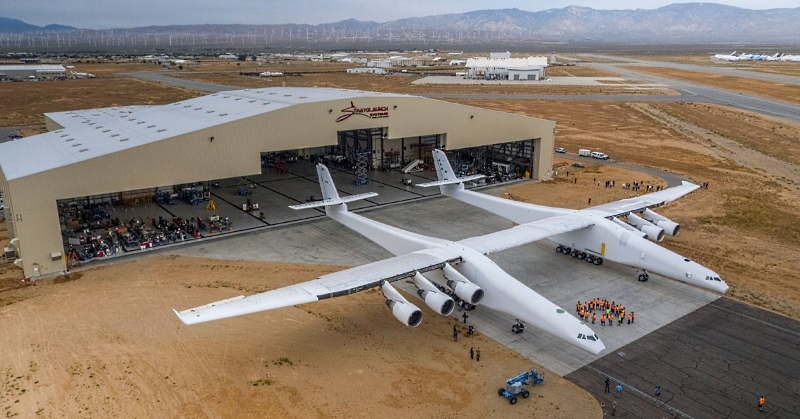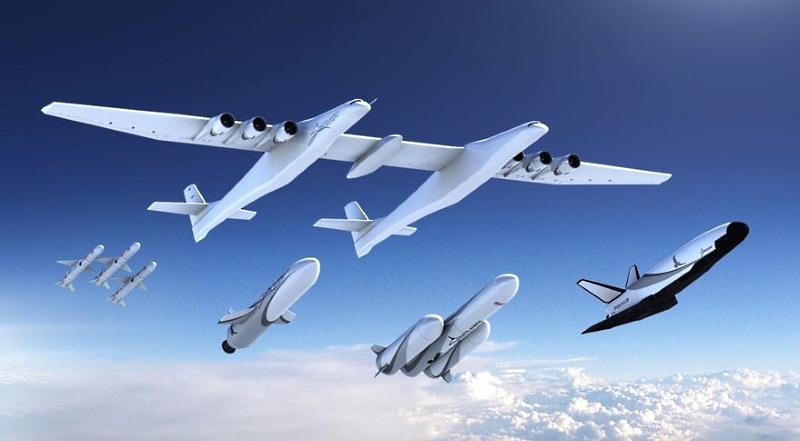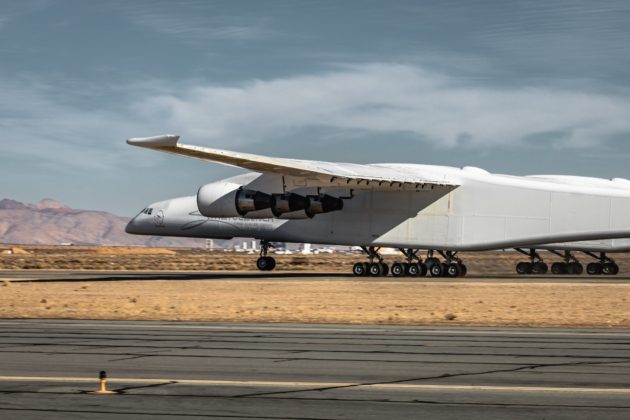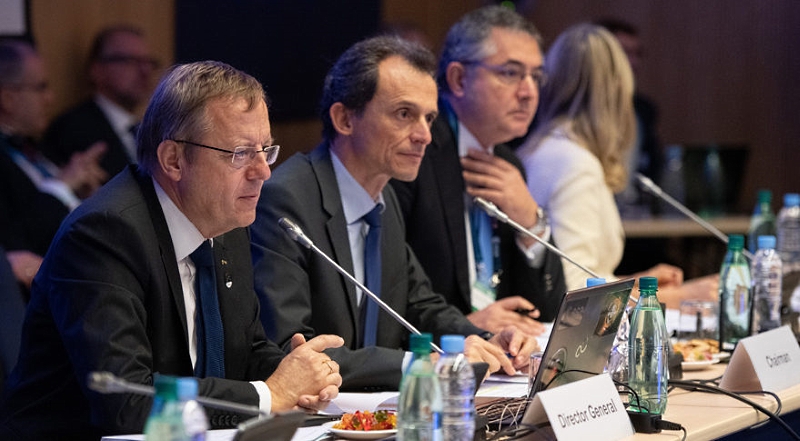Space challenges, cancellations and imminent hazards
Alas, not always space news is only good. Stratolaunch is closing the development of its launch vehicle, which raises questions about the demand for the giant plane that has not yet begun to fly, yet more clouds are gathering over the James Webb telescope, and even the director of the European Space Agency expects 2019 to be tense.

Photo: Stratolaunch

Photo: Stratolaunch
Beauty and big plans for the photo will not. In October 2018, the founder of Stratolaunch Paul Allen, known mainly as a co-founder of Microsoft, passed away. And now Stratolaunch is in the process of “straightening” a business that does not look rosy at all. The company has already laid off more than 50 people, and anonymous sources report that now only about twenty are working on the aircraft carrier. According to the latest news, work has also been stopped on the creation of its own launch vehicles for this aircraft. It is assumed that the giant double-bodied aircraft will launch Pegasus launch vehicles, which previously launched from the minimally modified passenger Lockheed L-1011. Problem: the capacity of the aircraft will be enough for three rockets, but they are not particularly in demand on the market now, and the last launches were in 2012, 2013 and 2016. AND,

Photo: Stratolaunch
Now the plane is being tested, on January 9, they successfully conducted a high-speed taxiing, the photos of which show the separation of the nose wheels. The first flight may occur very soon, but without a unique and competitive rocket, this project has a very doubtful future.

Mobile net room, which carries the James Webb telescope, December 2018, photo NASA
The US House of Representatives next week is going to put to the vote a bill on spending on commercial activities, law enforcement and science, which includes the allocation of 21.5 billion dollars for NASA. This is slightly less than last year, but more than what the Senate proposed to single out. This amount includes 304 million James Webb requested. However, the bulletin attached to the bill is not shy about expressions:

Johann-Dietrich Werner (left), photo by ESA
On January 16, Johann-Dietrich Werner, director of the European Space Agency, held an annual press breakfast where he told how the agency sees 2019. In a speech by Daniel Neuenschwander, Director of Space Communications, the year was directly described as tense. The old Ariane 5 and Vega missiles have ceased to be competitive, the agency is switching to Ariane 6 and Vega C, and now we need to think about whether it will be possible to upgrade these carriers in the future or now we should start working on new projects. According to Neuenschwander, the agency has been experiencing the greatest difficulties in the withdrawal sector since the Ariane 5 accident in 2002.
ESA also has difficulties due to the political situation - despite firm assurances that the UK will remain a member of the agency despite Brexit. ESA has no problem working with the national agencies of non-EU countries - Switzerland and Norway are members of ESA, not members of the EU. But, since it is still not clear how exactly Brexit will occur, it is required to be prepared for various possible scenarios.
On the financial side, the agency’s budget is larger than last year, but even there it was not without friction. The head of Airbus, Tom Enders, called for getting rid of the “geo-return” - a policy in which contracts are distributed according to the share of countries participating in ESA. Werner stressed that the rejection of the geo-return policy would be the end of the agency as such.
It is curious that the great efforts of ESA directs to PR. In the recently published survey results, it turned out that only 37% of Europeans know exactly what the European Space Agency is doing and, on average, overestimate their space costs by 20 times. The average European for ESA costs 10 euros per year, but people themselves think that they pay 200 euros for taxes. Obviously, in this area there is still something to work on.
There are weeks with more than the usual amount of sad news. I should add to the digest above, I hope, a temporary loss of communication with the Russian radio telescope Spectr-R. Despite the fact that the device worked longer than planned, it would be sad to lose it completely. But astronautics is a big industry, and there will always be good news. For example, on January 21, after a six-month hiatus, a new test flight of the New Shepard suborbital spacecraft is to take place. And if you read this material from 5:37 to 10:51 Moscow time, then a lunar eclipse will take place outside your window. The blood-red moon is beautiful and not at all scary, and if you are not lucky with the clouds, there are a lot of broadcasts on the Internet (I recommend slooh.com, but there will be others).

Photo: Stratolaunch
Aircraft without a rocket

Photo: Stratolaunch
Beauty and big plans for the photo will not. In October 2018, the founder of Stratolaunch Paul Allen, known mainly as a co-founder of Microsoft, passed away. And now Stratolaunch is in the process of “straightening” a business that does not look rosy at all. The company has already laid off more than 50 people, and anonymous sources report that now only about twenty are working on the aircraft carrier. According to the latest news, work has also been stopped on the creation of its own launch vehicles for this aircraft. It is assumed that the giant double-bodied aircraft will launch Pegasus launch vehicles, which previously launched from the minimally modified passenger Lockheed L-1011. Problem: the capacity of the aircraft will be enough for three rockets, but they are not particularly in demand on the market now, and the last launches were in 2012, 2013 and 2016. AND,

Photo: Stratolaunch
Now the plane is being tested, on January 9, they successfully conducted a high-speed taxiing, the photos of which show the separation of the nose wheels. The first flight may occur very soon, but without a unique and competitive rocket, this project has a very doubtful future.
Clouds over "James Webb"

Mobile net room, which carries the James Webb telescope, December 2018, photo NASA
The US House of Representatives next week is going to put to the vote a bill on spending on commercial activities, law enforcement and science, which includes the allocation of 21.5 billion dollars for NASA. This is slightly less than last year, but more than what the Senate proposed to single out. This amount includes 304 million James Webb requested. However, the bulletin attached to the bill is not shy about expressions:
NASA and contractors are deeply disappointed with their mismanagement, the complete lack of good supervision and the generally poor workmanship. <...> NASA and commercial contractors believe in vain that funding and support for Congress are unconditional and do not depend on the inability to meet the schedule and deadlines. <...> The maximum amount of spending on a telescope is increased by 802 million dollars, but NASA must meet the this amount. Otherwise, you will have to look for ways to cut costs or cancel the project.The story of “James Webb” is long and sad : the cost of the project has grown 19 times, and the time has shifted by 14 years. In parallel, stupid mistakes are made that further delay and increase the cost of the project. In complex engineering projects, unforeseen difficulties and delays are the norm, not the exception, and it is quite likely that the new set limit will not suffice. How bad the senators will be, and what they decide to do with the telescope now, alas, is unknown.
Tense 2019

Johann-Dietrich Werner (left), photo by ESA
On January 16, Johann-Dietrich Werner, director of the European Space Agency, held an annual press breakfast where he told how the agency sees 2019. In a speech by Daniel Neuenschwander, Director of Space Communications, the year was directly described as tense. The old Ariane 5 and Vega missiles have ceased to be competitive, the agency is switching to Ariane 6 and Vega C, and now we need to think about whether it will be possible to upgrade these carriers in the future or now we should start working on new projects. According to Neuenschwander, the agency has been experiencing the greatest difficulties in the withdrawal sector since the Ariane 5 accident in 2002.
ESA also has difficulties due to the political situation - despite firm assurances that the UK will remain a member of the agency despite Brexit. ESA has no problem working with the national agencies of non-EU countries - Switzerland and Norway are members of ESA, not members of the EU. But, since it is still not clear how exactly Brexit will occur, it is required to be prepared for various possible scenarios.
On the financial side, the agency’s budget is larger than last year, but even there it was not without friction. The head of Airbus, Tom Enders, called for getting rid of the “geo-return” - a policy in which contracts are distributed according to the share of countries participating in ESA. Werner stressed that the rejection of the geo-return policy would be the end of the agency as such.
It is curious that the great efforts of ESA directs to PR. In the recently published survey results, it turned out that only 37% of Europeans know exactly what the European Space Agency is doing and, on average, overestimate their space costs by 20 times. The average European for ESA costs 10 euros per year, but people themselves think that they pay 200 euros for taxes. Obviously, in this area there is still something to work on.
Conclusion
There are weeks with more than the usual amount of sad news. I should add to the digest above, I hope, a temporary loss of communication with the Russian radio telescope Spectr-R. Despite the fact that the device worked longer than planned, it would be sad to lose it completely. But astronautics is a big industry, and there will always be good news. For example, on January 21, after a six-month hiatus, a new test flight of the New Shepard suborbital spacecraft is to take place. And if you read this material from 5:37 to 10:51 Moscow time, then a lunar eclipse will take place outside your window. The blood-red moon is beautiful and not at all scary, and if you are not lucky with the clouds, there are a lot of broadcasts on the Internet (I recommend slooh.com, but there will be others).
